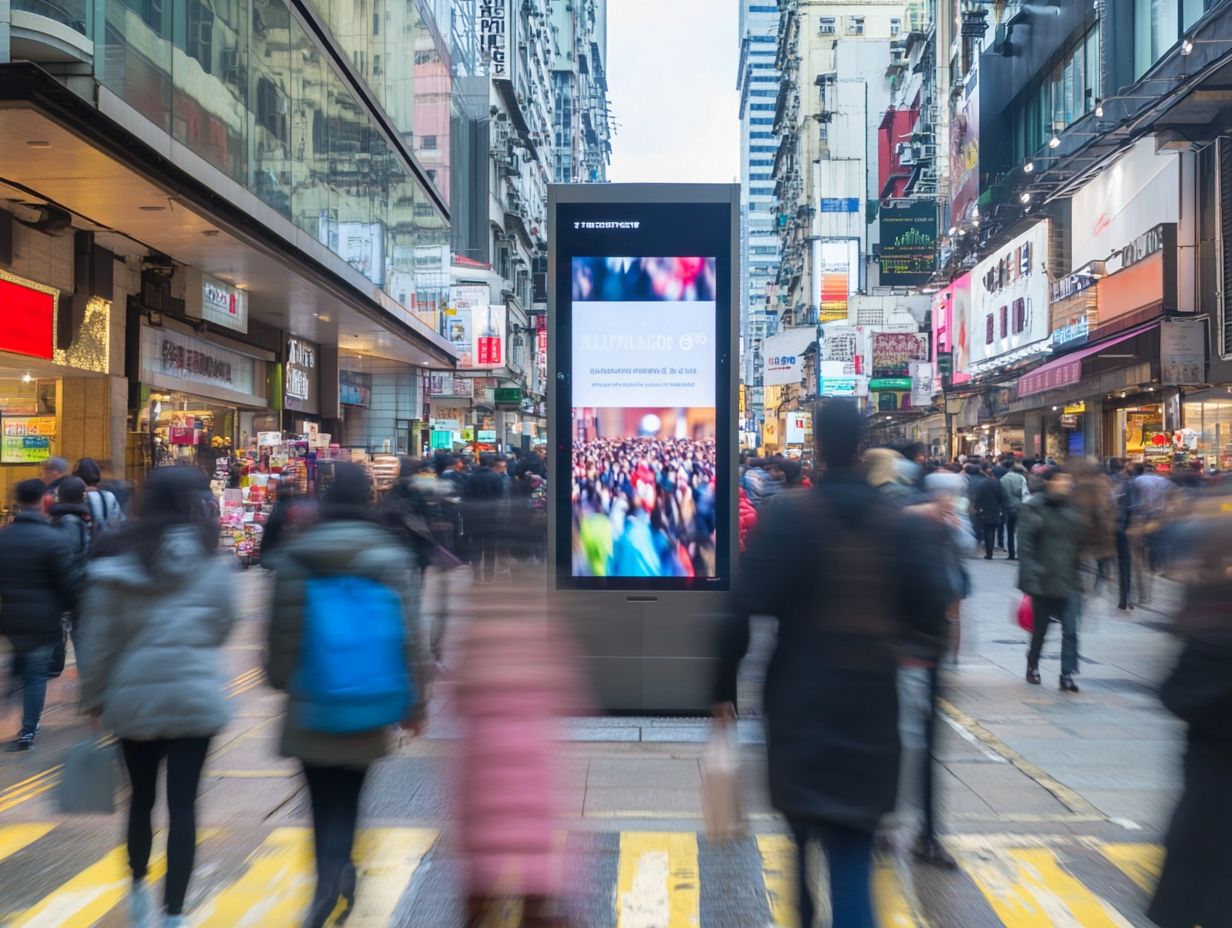In today’s data-driven world, understanding foot traffic data is essential for businesses looking to gauge the effectiveness of their marketing campaigns and improve retail performance through data-driven decisions.
This article explores the definition and significance of foot traffic data, providing insight into how it can be utilized to measure campaign impact, analyze visitor patterns, and enhance consumer behavior understanding.
Key metrics and tools for analysis will be discussed, along with common challenges and limitations, and best practices for accurate data collection.
Join us to uncover strategies to harness foot traffic data for marketing success, improve customer engagement, and optimize promotional strategies.
Understanding Foot Traffic Data

Foot traffic data refers to the measurement and analysis of the number of people entering a retail location within a specific time frame. This data provides valuable insights into consumer behavior, visitor patterns, and engagement patterns in physical spaces.
It plays a crucial role in marketing strategies, optimizing store layouts, and enhancing customer experiences by identifying peak foot traffic times and analyzing how these correlate with sales. This understanding enables brands to allocate resources more efficiently while maximizing their return on investment (ROI) and enhancing brand exposure.
By utilizing foot traffic data, brands can refine their marketing campaigns, gain insights into traffic sources, identify seasonal trends, and map customer journeys, leading to more strategic planning and well-considered choices.
Definition and Importance of Foot Traffic Data
Foot traffic data refers to the metrics and analytics that track customer movement within retail spaces. This data is essential for businesses aiming to enhance the customer experience and make informed marketing decisions.
Real-time foot traffic metrics provide valuable insights, such as the number of people entering and leaving a store, the duration of their visits, their return frequency, and their movement patterns inside the store. This information is useful for evaluating the effectiveness of store layout, promotional signage, and displays.
Retailers can identify their busiest and slowest times, enabling them to manage labor costs and inventory more effectively while improving operational efficiency. Moreover, leading businesses can leverage foot traffic data to create targeted marketing campaigns for specific customer segments, as they can analyze which products and displays attract customers initially.
This approach not only keeps retailers informed about evolving consumer behavior trends but also helps them create better shopping experiences, ultimately fostering stronger relationships with their customers.
Using Foot Traffic Data to Measure Marketing Campaign Impact

Foot traffic data is crucial for evaluating the effectiveness of marketing campaigns, as it enables businesses to measure the impact of various promotions and strategies on consumer behavior, store visits, and sales performance.
By analyzing location data and traffic volume, marketers can identify which campaigns effectively increase foot traffic and enhance customer engagement, ultimately influencing conversion rates and brand loyalty.
Implementing robust performance measurement of foot traffic data allows businesses to make data-driven decisions that optimize their marketing strategies and improve ROI by ensuring that campaigns reach the right audience and produce meaningful results.
Key Metrics and Tools for Analyzing Foot Traffic Data
Analyzing foot traffic data involves utilizing key metrics and analytics tools that allow businesses to measure and understand customer movement. This analysis is essential for optimizing marketing strategies and enhancing overall business performance.
It goes beyond merely counting the number of visitors; it also examines how customers interact within the space. For instance, by analyzing movement patterns at different times of the day and week, businesses can gain insights into peak traffic periods. This data can then be used to adjust promotions to align with high customer activity times.
Additionally, dwell time, which measures the amount of time customers spend in specific areas, can help identify which displays or sections of the store are capturing customers’ attention and facilitate behavioral analysis.
Analytical tools such as traffic counters, customer flow trackers, and point-of-sale systems can establish connections between foot traffic patterns and sales trends. This information allows businesses to modify their marketing strategies accordingly and leverage predicative analytics for better outcomes.
Challenges and Limitations of Using Foot Traffic Data

Foot traffic data is invaluable for understanding consumer behavior and engagement; however, there are challenges and limitations that must be addressed to ensure accurate interpretation and effective use.
Privacy concerns, data accuracy, and the inherent complexity of offline metrics complicate the assessment of the complete customer journey using foot traffic data. Furthermore, the absence of adequate data visualization tools and methodologies can hinder the ability to extract actionable insights from the collected information, potentially leading to misinterpretations and ineffective strategy implementation.
By recognizing the challenges and limitations associated with foot traffic data, organizations can adopt more strategic approaches to data collection and data analysis, ultimately enhancing the utility of this information.
Factors Affecting Foot Traffic and How to Address Them
The factors influencing foot traffic patterns can significantly impact consumer engagement and sales effectiveness in retail environments, prompting businesses to develop strategies to address these challenges, including market research and competitor analysis.
Key factors affecting foot traffic patterns include:
- Weather Conditions: Fluctuations in consumer turnout due to weather can greatly alter foot traffic patterns. Inclement weather often discourages people from shopping.
- Local Competition: The competitive landscape of a local area also affects foot traffic. Changes in local competition and economic conditions can shift shopping habits, leading customers to opt for alternative sources, such as online services.
- E-Commerce and Social Media Marketing: To counteract reductions in foot traffic, organizations may seek to enhance their digital presence by offering e-commerce options and utilizing social media for effective local marketing.
- Unique In-Store Experiences: Creating unique in-store experiences or hosting community events can effectively increase foot traffic, especially during peak seasons. This approach helps foster a connection with the customer base and promotes retention.
By developing a comprehensive understanding of these factors, organizations can successfully adapt and remain relevant in a changing retail landscape, ensuring business growth and sustained customer loyalty.
Best Practices for Utilizing Foot Traffic Data in Marketing Campaigns

Implementing best practices for utilizing foot traffic data in marketing campaigns is essential for maximizing the effectiveness of promotional strategies and ensuring that businesses achieve their desired outcomes through data-driven decisions.
Following best practices in data collection and interpretation helps ensure that insights derived from foot traffic analytics accurately reflect consumer behavior and preferences, allowing businesses to tailor marketing campaigns to meet their needs.
Key practices for leveraging foot traffic data in marketing campaigns include:
- A/B testing of marketing efforts
- Geo-targeting specific demographics
- Using real-time data to adapt strategies instantly
By adhering to these best practices, organizations can enhance their marketing campaigns, improve customer engagement, and drive revenue growth through more well-considered choices, achieving better ROI analysis.
Tips for Accurate Data Collection and Interpretation
Accurate data collection and interpretation are essential for developing effective marketing strategies based on reliable insights, particularly when using foot traffic data to enhance customer engagement and boost sales performance.
Businesses should utilize advanced behavioral analytics tools to ensure comprehensive data collection across various touchpoints and customer interactions.
Implementing real-time data tracking solutions enables organizations to adjust their marketing initiatives according to recent traffic patterns and promotional impacts, fostering a more agile environment for engaging with their target audience through effective audience reach strategies.
Investing in systems that accurately track customer behavior can reveal valuable patterns that inform decisions regarding product promotions and store layouts.
Incorporating customer feedback into data interpretation adds qualitative context to the figures, leading to a deeper understanding of consumer preferences.
Furthermore, it is crucial to establish a well-defined framework for analyzing this data, as insights derived from both quantitative and qualitative sources can help shape creative marketing strategies that resonate with the target demographic.
By employing these strategies, businesses can enhance the reliability of their data, allowing them to dynamically adjust their offerings in ways that foster customer loyalty and maximize ROI, ultimately improving brand awareness.





